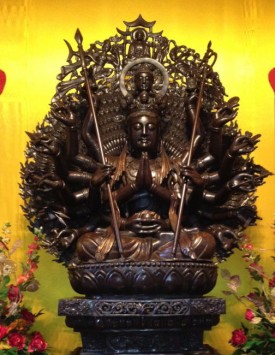A Bodhisattva is literally an enlightenment being. In Mahayana Buddhism, a Bodhisattva is a being who seeks buddhahood through the systematic practice of perfecting the paramitas but who renounces complete entry into nirvana until all beings are saved. A Bodhisattva is above the level of an Arhat or Lohan. Everything that Bodhisattvas do is for the benefit of sentient beings. There are ten to 15 different stages or paths (Bhumis) that one goes through on one’s journey to become a Buddha.
The six paramitas are also known as the six perfections, six perfect virtues, or six transcendent perfections. They are generosity (dana); moral discipline (sila); patience (ksanti); energy, vitality, diligence, or effort (virya); concentration (dhyana and samadhi); and wisdom (prajna). These represent the fundamental practices of Mahayana Buddhism. They are the virtues perfected by a Bodhisattva in the course of his or her development. The exoteric or open Mahayana path is also called the paramita path or bodhisattvayana, and usually takes eons to complete. The Vajrayana or secret path of the Mahayana, sometimes referred to as tantrayana, can result in much quicker results. However, no matter what particular school of Vajrayana Buddhism one may belong to, one must still constantly practice the six paramitas, and develop one’s bodhichitta as is done on the open path, along with the esoteric practices.
The principle samboghakaya Bodhisattvas who help us in our practice include the following. Click those that are underlined for more information:
Avalokiteshvara (Kuan Yin) Bodhisattva
Manjushri (Manjughosha) Bodhisattva
Sarvanivara Navishkambhin Bodhisattva
Vajrapani Bodhisattva: See Mahasthamaprapta Bodhisattva
Many of these great Bodhisattvas are actually ancient Buddhas who have assumed the form of Bodhisattvas to help living beings. Great Bodhisattvas, those above the seventh bhumi (stage or path), are also known as Mahasattvas. They are also known as non-returners, meaning that they can choose their place of rebirth and will not regress if they return to samsara to help living beings. This is not necessarily the case for lower level Bodhisattvas who can, in fact, devolve. Depending on how you start counting, there are 10-15 bhumis or levels of Bodhisattvas with the highest level being a Buddha.
There are also many Bodhisattvas who have taken nirmanakaya form and incarnated in this world to help living beings.
Some of the most well-known historical nirmanakaya Bodhisattvas in ancient India were;
Master Nagajuna
Master Aryadeva
Master Asvaghosa
Master Asangha
Master Chandrakirti
Master Dharmakirti
Master Dignaga
Master Shantideva
Master Vasubandhu
Master Padmasambhava (536 BCE-8th century): This great mahasiddha was from Uddiyana in what is now known as Kasmir (Afghanistan-Pakistan). He introduced into Tibet the esoteric teachings of the vajrayana and is one of the historical founders of Tibetan Buddhism. He is called Guru Rinpoche in Tibet, but his name literally means, “lotus-born.” He is said to have been born miraculously, appearing in a lotus flower.
Master Atisha
In Tibet there were:
Master Marpa
Master Milarepa
Master Sakya Pandita (1182-1251)
Master Tangtong Gyalpo
Master Sakya Pandita (1182-1251)
Master Tsongkapha (1361-1485): The Leonardo de Vinci of Tibet who was greatly accomplished in the five vidyas.
In China there were:
Master Bodhidharma
Master Hui Neng

